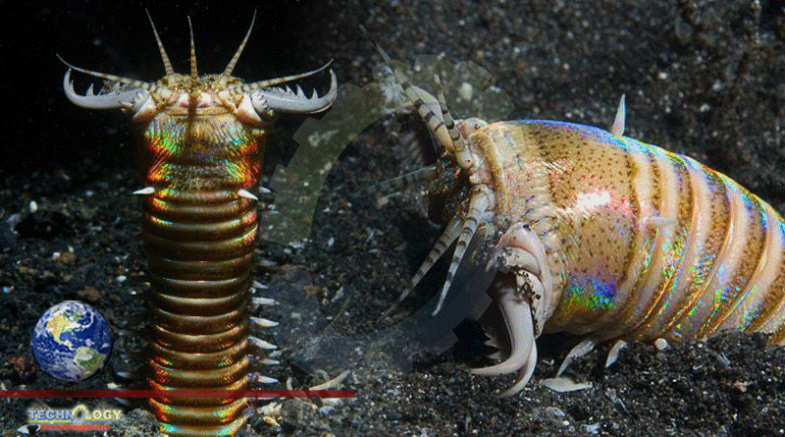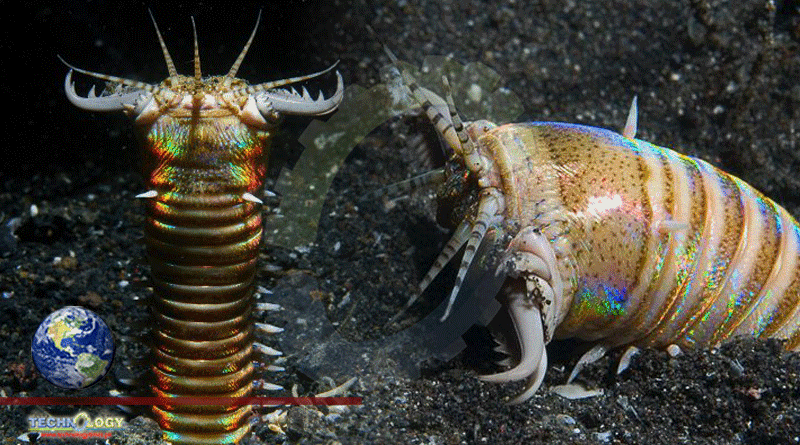Many Creatures Burrow Into The Sandy Seafloor, So The Trace Fossils Didn’t Seem Especially Out Of The Ordinary

Hidden Beneath The Seafloor around coral reefs, giant worms wait until an unlucky fish swims close enough for them to nab with their jagged, agile jaws and pull back into their sandy burrows. These rapid, deadly attacks have earned the worms the name sand strikers. Now, newly discovered fossilized burrows detailed in the journal Scientific Reports indicate that versions of these voracious sea worms were likely snacking on unsuspecting fish about 20 million years ago in what is now northern Taiwan.
Discovered in the Yehliu Geopark and Badouzi promontory of the island, the burrows are what are known as trace fossils—preserved imprints left behind by the activities of ancient animals. Trace fossils are valuable because they can preserve clues about a creature’s behavior. In this case, the prehistoric tubes, each over six feet long and about an inch wide, are trace fossils likely left behind by creatures that lived in the Cenozoic era, when this part of the world was underneath the ocean. Although modern sand strikers have been known to scientists since the late 18th century, researchers have only recently studied them in detail. The newfound fossils indicate that these vicious sea worms have likely been a part of ocean ecosystems through time immemorial, reinforcing the evolutionary advantages of their devious hunting technique.
Burrows left in the rock
Modern sand strikers are polychaete worms, belonging to the same group of animals as the sand worms that make little bubbles as the tide ebbs at the beach. But sand strikers can get much bigger than anything you’re likely to see at the shore. These consummate ambush predators range from just a few inches to nearly 10 feet in length, and they’re extremely sneaky. In 2009, workers at the Blue Reef Aquarium in England were puzzled when their fish kept disappearing, only to find a large sand striker—nicknamed Barry—that had gone undetected in the nooks and crannies of the reef habitat.
In 2013, Kochi University biologist Masakazu Nara was searching 20-million-year-old rocks in Taiwan for fossil impressions of stingray feeding behavior when he noticed series of strange burrows. At first, it seemed like these L-shaped burrows had been made by ancient shrimp, says National Taiwan University paleontologist and study co-author Ludvig Löwemark. Many creatures burrow into the sandy seafloor, so the trace fossils didn’t seem especially out of the ordinary.
Yet a definitive identification for the fossil eluded the scientists. It wasn’t until 2017, when an international conference of trace fossil experts gathered in Taipei, Taiwan, that Löwemark and colleagues were able to compare notes. The burrows didn’t match anything seen in the fossil record before. “The fact that nobody had seen something similar convinced us that this is a new trace fossil species,” Löwemark says. Determining exactly what made the burrows, however, required more detective work. “It’s not one feature that convinced us this burrow was made by a worm,” Löwemark says, “but the combination of features.” The tops of the burrows seemed to have collapsed and left feather-like impressions in the rock, suggesting they were used over and over by an animal moving in and out. “The funnels indicate a violent event,” Löwemark adds, like a worm exploding from its burrow rather than a clam inching its way out of the sand.
A key piece of geochemical evidence solidified the case. The tops of the burrows are very rich in iron, suggesting that whatever made them was seeping mucus along the upper walls to help maintain the structure’s shape. Bacteria then fed on this goo, producing iron sulfide. This mucus-fortification matches the burrows of sand strikers today. Also, the ancient sand at the tops of the burrows seems to have been regularly disturbed, indicating that it was likely occupied by an ambush predator. Sand strikers are a good fossil fit. “Such huge burrows with those feather-like disruption features are dead ringer traces for these worms,” says University of Bristol paleontologist Jakob Vinther, who was not involved in the new study. The size of the burrows and the way the sand was altered by the invertebrates’ behavior also matches up, he says.
Sand strikers throughout history
Most of the time, trace fossils are described and given names without identifying the specific creature that made them, says University of Alberta paleontologist Murray Gingras. That’s because trace fossils and body fossils are only rarely found together. The new paper, which gives the name Pennichnus formosae to the fossil burrows, makes a good case for a sand striker interpretation, he notes, but body fossils would help confirm what the traces imply. “Since the worm is almost entirely made up of soft tissue,” Löwemark says, “the chances of preservation are extremely small.” Still, the characteristic, multi-pronged jaws of sand strikers are made of hardened proteins and can be tipped with zinc, so they have a better chance of showing up in the fossil record. “These types of jaws, I believe, go back to the Ordovician period,” Vinther says, referring to a time over 443 million years ago. There are some older fossils attributed to these types of worms. Rocks about 400 million years old in Ontario, Canada, contain signs of worms behaving similar to sand strikers today. However, it’s somewhat strange that more fossils like these haven’t been found yet. Based on how distinctive and large these burrows can be, such traces should be relatively common in rocks from the past 20 million years, Gingras says. Perhaps scientists are only just learning to recognize them, and with a little luck, paleontologists may be able to track these worms back into their most ancient burrows—if they dare.
This news was originally published at National Geographic
